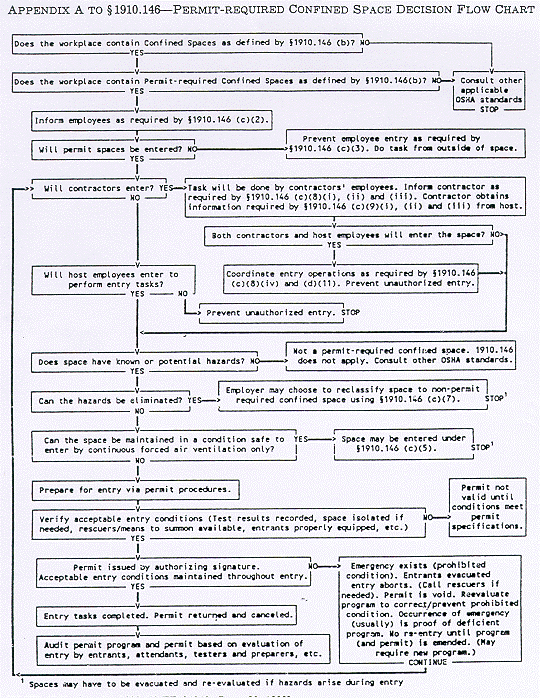

DEFINITIONS APPLICABLE TO THIS PROCEDURE
|
Atmosphere |
The gases, vapors, mists, fumes and dusts within a confined space. |
|
Attendant |
A trained individual stationed outside one or more permit spaces who monitors the authorized entrants and who performs all attendant’s duties assigned in the employer’s permit space program.
|
|
Authorized entrant |
A trained employee who is authorized by the employer or the employer’s designee to enter a permit only confined space. |
|
Blanking or blinding |
The absolute closure of a pipe, line, or duct by the fastening of a solid plate (such as a spectacle blind or skillet blind) that completely covers the bore and that is capable of withstanding the maximum pressure of the pipe, line, or duct with no leakage beyond the plate.
|
|
Emergency |
Any occurrence (including any failure of hazard control or monitoring equipment) or event internal or external to the space that could endanger entrants. |
|
Engulfment |
The surrounding and effective capture of a person by a liquid or finely divided (flowable) solid substance that can be aspirated to cause death by filling or plugging the respiratory system or that can exert enough force on the body to cause death by strangulation, constriction, or crushing. |
|
Entry |
The action by which a person passes through an opening into a permit-required confined space. Entry includes ensuing work activities in that space and is considered to have occurred as soon as any part of the entrant’s body breaks the plane of an opening into the space. |
|
Entry Permit |
The written or printed document that is provided by the employer to allow and control entry into a permit space. |
|
Entry supervisor |
The designated person responsible for determining if acceptable entry conditions are present at a permit space where entry is planned, for authorizing entry and overseeing entry operations and for terminating entry as required by this procedure. |
|
Hazardous atmosphere |
Means an atmosphere that may expose employees to the risk of death, incapacitation, impairment of ability to self-rescue (that is, escape unaided from a permit space), injury, or acute illness from one or more of the following causes: |
|
|
1. Flammable gas, vapor, or mist in excess of 10% of its lower flammable level (LFL); |
|
|
2. Airborne combustible dust at a concentration that meets or exceeds its LFL, |
|
|
3. Atmospheric oxygen concentration below 19.5% or above 23.5% |
|
|
4. Atmospheric oxygen concentration of any substance for which a dose or permissible exposure limit is published in Subpart G, Occupational Health and Environmental Control, or in Subpart Z, Toxic and Hazardous Substances, of the Code of Federal Regulations. |
|
|
5. Any other atmospheric condition that is immediately dangerous to life or health. |
|
Immediately dangerous- |
Any condition that poses an immediate or delayed threat to life or health (IDLH) life or health that would interfere with an individual’s ability to escape unaided from a permit space. |
|
Isolation - |
The process by which a permit space is removed from service and completely protected against the release of energy and material into the space by such means as blanking or blinding; misaligning or removing sections of lines, pipes, or ducts; a double block and bleed system, lockout or tagout of al sources of energy; or blocking or disconnecting all mechanical linkages. |
|
Line breaking- |
The intentional opening of a pipe, line, or duct that is or has been carrying flammable, corrosive, or toxic material, an inert gas, or any fluid at a volume, pressure, or temperature capable of causing injury. |
|
Lower explosive Limit (LEL)- |
The minimum concentration of a combustible gas or vapor in air, which will ignite if an ignition source is present. |
|
Non-permit confined space- |
A confined space that does not contain or, with respect to atmospheric hazards, have the potential to contain any hazard capable of causing death or serious physical harm. |
|
Oxygen deficient atmosphere- |
An atmosphere containing less than 19.5% oxygen by volume. |
|
Oxygen enriched atmosphere- |
An atmosphere containing more than 23.5% oxygen by volume. |
|
Permissible Exposure Limit- |
The maximum 8 hour time weighted average of any airborne containment to which an employee may be exposed. |
See Permit-Required Confined Space Decision Flow Chart Below, per 1910.146, appendix A
Added to file February 2, 2001